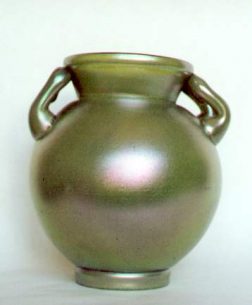 Today, we take a dim view of imitation in the world of manufacturing. “Knockoffs” are branded unoriginal, uninspired, flimsier versions of the original. In the long-ago Kingdom of Bohemia, however, imitation truly flattered Loetz when Kralik glassworks decided to jump on the Jugendstil bandwagon in the late 1800s, mimicking the art glass techniques Loetz had pioneered with an incredibly creative range of its own designs and methods.
Today, we take a dim view of imitation in the world of manufacturing. “Knockoffs” are branded unoriginal, uninspired, flimsier versions of the original. In the long-ago Kingdom of Bohemia, however, imitation truly flattered Loetz when Kralik glassworks decided to jump on the Jugendstil bandwagon in the late 1800s, mimicking the art glass techniques Loetz had pioneered with an incredibly creative range of its own designs and methods.
Alas, Kralik’s quality has paradoxically had a detrimental effect on its legacy—owing to the very high market value of antique Loetz pieces, Kralik is often falsely passed off as Loetz at auctions, blending the two glassmakers’ styles in the minds of many. Alfredo Villanueva-Collado, an avid long-time collector of Bohemian Jugendstil glass, explains the difficulty this presents to even the most meticulous researcher of art glass: “Given the prices at which it is being marketed when labeled “Loetz,” getting Kralik glass to be recognized on its own has perhaps become the most challenging task for the researcher of Bohemian Jugendstil glass. First, there are very few authenticated pieces, since Kralik followed the standard period practice of not signing its pieces, except cameos, many pieces being misidentified in some of the major art glass publications of the 60’s, 70’s and 80’s, such as the 1969 Villa-Stuck Museum exhibition catalogue, the Brohan Collection catalogue from 1976, and innumerable Christie’s and Sotheby’s art glass sales catalogues. Based on such information, I myself misclassified pieces by Kralik in my first article on Bohemian Jugendstil glass.”
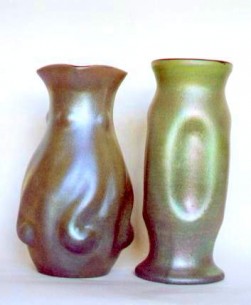 Some collectors (such as Wes Nedblake) go so far as to postulate that Kralik was an affiliate of Loetz, produced glass for Loetz (which is said to match Loetz’s quality seamlessly), or even that Kralik quietly surpassed Loetz at mastering certain techniques, such as casing glass. On what evidence such claims are based, few seem to know.
Some collectors (such as Wes Nedblake) go so far as to postulate that Kralik was an affiliate of Loetz, produced glass for Loetz (which is said to match Loetz’s quality seamlessly), or even that Kralik quietly surpassed Loetz at mastering certain techniques, such as casing glass. On what evidence such claims are based, few seem to know.
What little we do know about the authentic history of Kralik has really only come to light over the last decade, as deeper research into the world of Jugendstil glass and an end to blind Loetz-mania piqued a strong interest in Kralik for its own sake.
Kralik Glassworks gets its name from Wilhelm Ritter von Kralik, the nephew of an award-winning glassmaker by the name of Jan Meyr. Upon Meyr’s passing in 1841, his glasshouse was passed on to both von Kralik and his other nephew, Josef Taschek. Upon Taschek’s death, the company was renamed “Meyr’s Neffe”.
The glassworks puttered along relatively unremarkably until Von Kralik himself passed and the company was divided up between his four sons, with Karl Kralik’s half retaining the Meyr’s Neffe name; according to Belgian art glass collector Eddy Scheepers, this is when the firm began to garner widespread recognition for its quality (both of design and production): “Meyr’s Neffe was indeed a well known and highly regarded glass factory that worked for such famous designers as Hoffmann, Prutcher in collaboration with Lobmeyer and Bakalowitz in Vienna. Their production was completely different from what we commonly know as Kralik.” Scheepers goes on to explain that what we generally think of when we think of Kralik arose from the work of the other two sons: “The other half of the company was taken over by Heinrich and Johann Kralik. They started working as ‘Wilhelm Kralik Sohn’ in Eleonoranhein and Ernstbrunn. This is the Kralik we know best.” Scheepers notes that he has never found any evidence whatsoever to support the theory that any of the branches of the Kralik company were ever affiliates of Loetz.
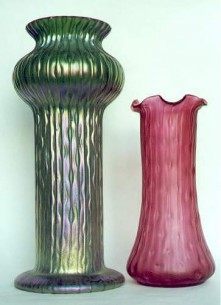 It was only upon Johan’s retirement that Kralik became one single united firm; at this point, the two branches were amalgamated by Heinrich Kralik (likely some time around 1922), and became known only as Wilhelm Kralik Sohne. The company continued to produce glass in the Art Deco style until, like so many great glassworks, it succumbed to the devastation of World War Two, closing its doors forever and leaving us with the task of preserving its legacy despite its almost complete lack of signed pieces.
It was only upon Johan’s retirement that Kralik became one single united firm; at this point, the two branches were amalgamated by Heinrich Kralik (likely some time around 1922), and became known only as Wilhelm Kralik Sohne. The company continued to produce glass in the Art Deco style until, like so many great glassworks, it succumbed to the devastation of World War Two, closing its doors forever and leaving us with the task of preserving its legacy despite its almost complete lack of signed pieces.
While embarking on this challenging endeavour, collector Alfredo Villanueva-Collado has managed to identify the following lines and styles which he believes are verifiably Kralik:
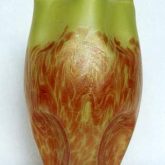 -The “Helios” line, characterized by opaque yellow glass with spotted orange decoration.
-The “Helios” line, characterized by opaque yellow glass with spotted orange decoration.
-Another unnamed line which “consists of vessels in purple or green glass, criss-crossed by wide iridescent silver or rainbow-colored bands.” This style is commonly seen in the form of vases and inkwells made my Kralik.
-Glass styled with a surface treatment consisting of “smooth irregular lines in a mixture of red and creamy beige, with silvery blue iridescence.”
-Glass styled in white martelé with the application of flowers, fruits, or other decorations that were simply “stuck on”.
-A line of blue or pink glass that strongly imitated Loetz Candia, being covered with pulverized glass, creating a soft, matte sheen.

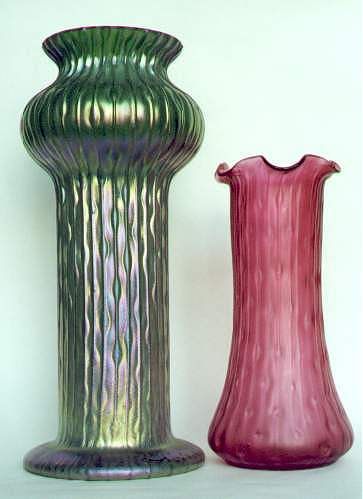
A sad ending for such an illustrious name. Sigfried kralik was one of the many Sudeten Germans who collaborated with the Nazis. That is the reason the Kraliks have been erased from official Czech history.